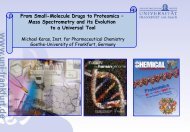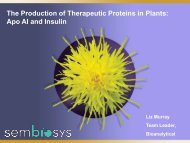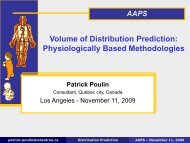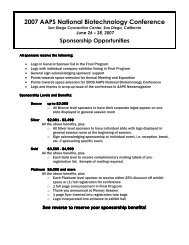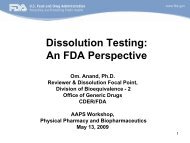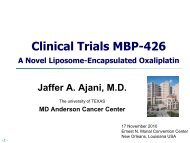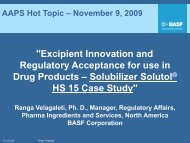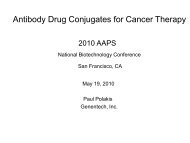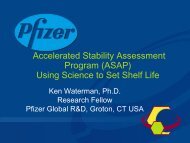The Role of Pharmacist in Education of
The Role of Pharmacist in Education of
The Role of Pharmacist in Education of
Create successful ePaper yourself
Turn your PDF publications into a flip-book with our unique Google optimized e-Paper software.
2010 FIP PSWC/AAPS<br />
Annual Meet<strong>in</strong>g & Exposition<br />
Tuesday afternoon m<strong>in</strong>i-symposia<br />
<strong>The</strong> <strong>Role</strong> <strong>of</strong> <strong>Pharmacist</strong> <strong>in</strong> <strong>Education</strong> <strong>of</strong><br />
Pharmacogenetics and Pharmacogenomics <strong>in</strong><br />
Japan<br />
2010.11.16<br />
Toshiyuki Sakaeda<br />
Kyoto University, Japan
<strong>The</strong> <strong>Role</strong> <strong>of</strong> <strong>Pharmacist</strong> <strong>in</strong> <strong>Education</strong> <strong>of</strong><br />
Pharmacogenetics & Pharmacogenomics <strong>in</strong> Japan<br />
‣ Introduction<br />
‣ Package <strong>in</strong>serts <strong>in</strong> Japan<br />
‣ Inclusion <strong>in</strong> rout<strong>in</strong>e cl<strong>in</strong>ical practice<br />
--- <strong>The</strong> University <strong>of</strong> Tokyo Hospital ---<br />
‣ Key problems<br />
‣ Summary
<strong>The</strong> <strong>Role</strong> <strong>of</strong> <strong>Pharmacist</strong> <strong>in</strong> <strong>Education</strong> <strong>of</strong><br />
Pharmacogenetics & Pharmacogenomics <strong>in</strong> Japan<br />
‣ Introduction<br />
‣ Package <strong>in</strong>serts <strong>in</strong> Japan<br />
‣ Inclusion <strong>in</strong> rout<strong>in</strong>e cl<strong>in</strong>ical practice<br />
--- <strong>The</strong> University <strong>of</strong> Tokyo Hospital ---<br />
‣ Key problems<br />
‣ Summary
106,000 patients/year<br />
Estimated number <strong>of</strong> patients<br />
with fatal adverse drug reaction<br />
<strong>in</strong> USA, 1994<br />
J.Lazarou, et al., JAMA, 279, 1200-1205, 1998.
Estimated number <strong>of</strong> patients with<br />
adverse drug reaction <strong>in</strong> USA, 1994<br />
Serious<br />
Fatal<br />
Inpatients 702,000 63,000<br />
Outpatients 1,547,000 43,000<br />
Overall 2,216,000 106,000<br />
J.Lazarou, et al., JAMA, 279, 1200-1205, 1998.
Estimated number <strong>of</strong> patients with<br />
Cause <strong>of</strong> death<br />
adverse drug reaction USA, 1994 <strong>in</strong> USA, 1994<br />
Heart disease 743,000<br />
Cancer 530,000<br />
Serious<br />
Stroke 150,000<br />
Fatal<br />
Inpatients Pulmonary 702,000 101,000 63,000<br />
Accidents 91,000<br />
Outpatients 1,547,000 43,000<br />
Overall 2,216,000 106,000<br />
J.Lazarou, et al., JAMA, 279, 1200-1205, 1998.
To optimize the pharmacotherapy<br />
‣ To diagnose accurately<br />
‣ To select a right drug for a right patient<br />
‣ To set a right dosage for a right patient<br />
‣ To use as directed<br />
‣ To assess the outcome <strong>of</strong> pharmacotherapy
To optimize the pharmacotherapy<br />
‣ To diagnose accurately<br />
‣ To select a right drug for a right patient<br />
‣ To set a right dosage for a right patient<br />
‣ To use as directed<br />
‣ To assess the outcome <strong>of</strong> pharmacotherapy
Pharmacogenetics and pharmacogenomics<br />
‣ Pharmacogenetics - co<strong>in</strong>ed <strong>in</strong> the late 1950s<br />
<strong>The</strong> study <strong>of</strong> genetic causes <strong>of</strong> <strong>in</strong>dividual variations<br />
<strong>in</strong> drug response<br />
‣ Pharmacogenomics - recently co<strong>in</strong>ed term<br />
<strong>The</strong> genome-wide analysis <strong>of</strong> genetic determ<strong>in</strong>ants<br />
<strong>of</strong> drug efficacy and toxicity<br />
K.C.Lee, et al., J.Am.Pharm.Assoc., 50, e1-e17, 2010.
Plasma concentration ( ng/mL )<br />
Plasma concnetration-time curves <strong>of</strong><br />
omeprazole after oral adim<strong>in</strong>istration<br />
1250<br />
1000<br />
750<br />
500<br />
CYP2C19*2/*2 or *2/*3 or *3/*3<br />
CYP2C19*1/*2 or *1/*3<br />
CYP2C19*1/*1<br />
Poor metabolizers<br />
= genetic defect <strong>of</strong> CYP2C19 activity<br />
250<br />
0<br />
0 4 8 12<br />
Time ( hr )<br />
Extensive metabolizers<br />
T.Sakai et al., Pharm.Res., 18, 721-727, 2001.
Intra-gastric pH<br />
10<br />
9<br />
8<br />
7<br />
6<br />
5<br />
4<br />
3<br />
2<br />
1<br />
Intra-gastric pH after oral adm<strong>in</strong>istration <strong>of</strong><br />
omeprazole <strong>in</strong> CYP2C19*3/*3<br />
20 mg omeprazole<br />
omeprazole<br />
0<br />
9:00 15:00 21:00 3:00 9:00<br />
meal<br />
Time<br />
20 mg omeprazole<br />
basal<br />
T.Kita et al., Pharm.Res., 18, 615-621, 2001.
Intra-gastric pH<br />
10<br />
9<br />
8<br />
7<br />
6<br />
5<br />
4<br />
3<br />
2<br />
1<br />
Intra-gastric pH after oral adm<strong>in</strong>istration <strong>of</strong><br />
omeprazole <strong>in</strong> CYP2C19*1/*1<br />
20 mg omeprazole<br />
0<br />
9:00 15:00 21:00 3:00 9:00<br />
meal<br />
Time<br />
20 mg omeprazole<br />
omeprazole<br />
basal<br />
T.Kita et al., Pharm.Res., 18, 615-621, 2001.
CYP2C19-meidtaed activation <strong>of</strong><br />
an antiplatelet agent, Clopidogrel<br />
CYP2C19<br />
Clopidogrel<br />
[ prodrug ]<br />
CYP2C19<br />
Active metabolite<br />
‣ Activated by CYPs<br />
‣ Ma<strong>in</strong> is<strong>of</strong>orm is CYP2C19.<br />
‣ Active metabolite b<strong>in</strong>ds with platelet<br />
ADP receptor via disulfide bridge
CYP2C19 genetic polymorphisms<br />
and clopidogrel effects<br />
Estimated rate (%) <strong>of</strong><br />
1) death from any cause,<br />
2) nonfatal myocardial <strong>in</strong>farction, or<br />
3) stroke<br />
‣ Patients with def<strong>in</strong>ite acute<br />
myocardial <strong>in</strong>farction who were<br />
admitted to ICUs<br />
12<br />
10<br />
8<br />
6<br />
4<br />
2<br />
CYP2C19 *2 or *3 carrier<br />
CYP2C19 *1/*1<br />
p=0.01<br />
‣ Treated with clopidogrel<br />
0<br />
0 90 180 270 360 450<br />
Days<br />
T.Simon et al., N. Engl. J. Med., 360, 363-375, 2009.
<strong>The</strong> <strong>Role</strong> <strong>of</strong> <strong>Pharmacist</strong> <strong>in</strong> <strong>Education</strong> <strong>of</strong><br />
Pharmacogenetics & Pharmacogenomics <strong>in</strong> Japan<br />
‣ Introduction<br />
‣ Package <strong>in</strong>serts <strong>in</strong> Japan<br />
‣ Inclusion <strong>in</strong> rout<strong>in</strong>e cl<strong>in</strong>ical practice<br />
--- <strong>The</strong> University <strong>of</strong> Tokyo Hospital ---<br />
‣ Key problems<br />
‣ Summary
Descriptions <strong>in</strong> package <strong>in</strong>serts <strong>in</strong> Japan<br />
‣ Omeprazole<br />
CYP2C19*2, *3<br />
‣ Clopidogrel<br />
CYP2C19*2, *3<br />
‣ Carbamazep<strong>in</strong>e<br />
HLA-B*1502<br />
‣ Abacavir<br />
HLA-B*1501<br />
blood concentration<br />
active metabolite<br />
Stevens-Johnson, Lyell<br />
Hypersensitivity
Descriptions <strong>in</strong> package <strong>in</strong>serts <strong>in</strong> Japan<br />
‣ Azathiopr<strong>in</strong>e<br />
TPMT*3 blood concentration<br />
‣ Mercaptopur<strong>in</strong>e<br />
TPMT*3 blood concentration<br />
‣ Ir<strong>in</strong>otecan<br />
UGT1A1*6, *28 serious adverse events<br />
‣ Warfar<strong>in</strong><br />
CYP2C9*3 blood concentration
Package <strong>in</strong>sert <strong>of</strong> CPT-11 <strong>in</strong> Japan<br />
‣ Pay attention to <strong>in</strong>dividuals harbor<strong>in</strong>g UGT1A1*6<br />
or *28 allele, s<strong>in</strong>ce they are reportedly at <strong>in</strong>creased<br />
risk for serious adverse events (neutropenia) due to<br />
delay <strong>in</strong> the elim<strong>in</strong>ation <strong>of</strong> an active metabolite,<br />
SN-38.<br />
A large-scale prospective<br />
No recommendation<br />
cl<strong>in</strong>ical <strong>in</strong>vestigation on<br />
for dose reduction<br />
the effects <strong>of</strong> dose-reduction
<strong>The</strong> <strong>Role</strong> <strong>of</strong> <strong>Pharmacist</strong> <strong>in</strong> <strong>Education</strong> <strong>of</strong><br />
Pharmacogenetics & Pharmacogenomics <strong>in</strong> Japan<br />
‣ Introduction<br />
‣ Package <strong>in</strong>serts <strong>in</strong> Japan<br />
‣ Inclusion <strong>in</strong> rout<strong>in</strong>e cl<strong>in</strong>ical practice<br />
--- <strong>The</strong> University <strong>of</strong> Tokyo Hospital ---<br />
‣ Key problems<br />
‣ Summary
To <strong>in</strong>clude <strong>in</strong> rout<strong>in</strong>e cl<strong>in</strong>ical practice<br />
<strong>The</strong> case <strong>of</strong> <strong>The</strong> University <strong>of</strong> Tokyo Hospital<br />
‣ Much evidence has been accumulat<strong>in</strong>g over the last decade.<br />
‣ A part <strong>of</strong> knowledge has already been translated <strong>in</strong>to diagnostic tools.<br />
‣ It is important to establish “the system”.<br />
<strong>Pharmacist</strong>s can play an important role<br />
<strong>in</strong> rout<strong>in</strong>e cl<strong>in</strong>ical practice.
PGx work<strong>in</strong>g group <strong>in</strong> the University <strong>of</strong> Tokyo Hospital<br />
PGx work<strong>in</strong>g group<br />
Cl<strong>in</strong>ical Genomics Dept.<br />
Total consultation<br />
Cl<strong>in</strong>ical Laboratory<br />
DNA extraction & storage<br />
Genotyp<strong>in</strong>g<br />
Cl<strong>in</strong>ical Informatics Dept.<br />
Data cod<strong>in</strong>g<br />
Information management<br />
Pharmaceutical Dept.<br />
Obta<strong>in</strong><strong>in</strong>g <strong>of</strong> <strong>in</strong>formed consent<br />
PGx <strong>in</strong>formation consultation<br />
IRB support<br />
Each <strong>of</strong> cl<strong>in</strong>ical divisions<br />
Patient's enrollment<br />
Exploitation <strong>of</strong> data
Scheme <strong>of</strong> outpatient genotyp<strong>in</strong>g<br />
1 st visit<br />
Patient<br />
Doctor<br />
PGx test<strong>in</strong>g order<br />
2 nd visit<br />
Patient<br />
<strong>Pharmacist</strong><br />
Obta<strong>in</strong><strong>in</strong>g <strong>of</strong> <strong>in</strong>formed consent Blood sampl<strong>in</strong>g Genotyp<strong>in</strong>g<br />
3 rd visit<br />
Record<strong>in</strong>g<br />
<strong>Pharmacist</strong><br />
<strong>Pharmacist</strong><br />
Consultation for patient<br />
Consultation for doctor
Personal <strong>in</strong>formation confidentiality<br />
Name:Babe Ruth<br />
Patient ID: 1-234-567<br />
PGx ID number is automatically and<br />
randomly coded by computer<br />
Label for PGx test<strong>in</strong>g<br />
PGx ID: 7-654-321
Leaflets for PGx test<strong>in</strong>g<br />
for consultation<br />
with <strong>in</strong>formed consent
Informed consent
<strong>The</strong> <strong>Role</strong> <strong>of</strong> <strong>Pharmacist</strong> <strong>in</strong> <strong>Education</strong> <strong>of</strong><br />
Pharmacogenetics & Pharmacogenomics <strong>in</strong> Japan<br />
‣ Introduction<br />
‣ Package <strong>in</strong>serts <strong>in</strong> Japan<br />
‣ Inclusion <strong>in</strong> rout<strong>in</strong>e cl<strong>in</strong>ical practice<br />
--- <strong>The</strong> University <strong>of</strong> Tokyo Hospital ---<br />
‣ Key problems<br />
‣ Summary
Key problems <strong>in</strong> Japan<br />
‣ F<strong>in</strong>ite healthcares budgets<br />
1. From 2009.4, national/public health <strong>in</strong>surance<br />
covers UGT1A1 genotyp<strong>in</strong>g<br />
2. Coverage: 20,000 JPY ( = 245 USD / 178 EUR )<br />
3. Cost: 31,500 JPY<br />
Who pays 11,500 JPY
We do need<br />
‣ Inf<strong>in</strong>ite healthcares budgets<br />
‣ A diagnostic tool with lower cost ( )<br />
‣ Cost-effective appraisal<br />
‣ <strong>Education</strong> <strong>of</strong> citizens and medical staffs
We do need<br />
‣ Inf<strong>in</strong>ite healthcares budgets<br />
‣ A diagnostic tool with lower cost ( )<br />
‣ Cost-effective appraisal<br />
‣ <strong>Education</strong> <strong>of</strong> citizens and medical staffs<br />
Cl<strong>in</strong>ical systems are cont<strong>in</strong>uously progressed,<br />
and new <strong>in</strong>tervention must have<br />
an additional value, than current practice.
In the pharmacotherapy<br />
with antidepressant medications<br />
‣ <strong>The</strong> therapy start with lower dose and the<br />
dose will be cont<strong>in</strong>uously elevated until<br />
f<strong>in</strong>d<strong>in</strong>g <strong>of</strong> the best dose for each <strong>of</strong><br />
patients.<br />
‣ CYP2D6 genotyp<strong>in</strong>g might not be necessary.
For the optimization <strong>of</strong><br />
pharmacotherapy with warfar<strong>in</strong><br />
‣ A handy-type simple diagnostic tool <strong>of</strong> INR<br />
has been developed.<br />
‣ How we use VKORC1 and CYP2C9 genetic<br />
<strong>in</strong>formation
F<strong>in</strong>ite healthcares budgets might suggest<br />
‣ That this new technology do not have the<br />
power now.<br />
‣ That we have to demonstrate the value,<br />
when compared with current practice.
<strong>The</strong> <strong>Role</strong> <strong>of</strong> <strong>Pharmacist</strong> <strong>in</strong> <strong>Education</strong> <strong>of</strong><br />
Pharmacogenetics & Pharmacogenomics <strong>in</strong> Japan<br />
‣ Introduction<br />
‣ Package <strong>in</strong>serts <strong>in</strong> Japan<br />
‣ Inclusion <strong>in</strong> rout<strong>in</strong>e cl<strong>in</strong>ical practice<br />
--- <strong>The</strong> University <strong>of</strong> Tokyo Hospital ---<br />
‣ Key problems<br />
‣ Summary
Summary<br />
‣ A number <strong>of</strong> evidences that the genotyp<strong>in</strong>g-guided<br />
pharmacotherapy enables us to ensure a certa<strong>in</strong> level<br />
<strong>of</strong> efficacy and to avoid serious adverse reactions.<br />
‣ A part <strong>of</strong> knowledge has already been translated <strong>in</strong>to<br />
diagnostic tools.<br />
‣ However <strong>in</strong> Japan, it is still hard to <strong>in</strong>clude this new<br />
technology <strong>in</strong> rout<strong>in</strong>e cl<strong>in</strong>ical practice.
Summary<br />
‣ <strong>The</strong> f<strong>in</strong>ite healthcares budgets require demonstrat<strong>in</strong>g<br />
that this novel <strong>in</strong>tervention provides an additional<br />
value, when compared with current practice.<br />
‣ In addition to cost-effective appraisal, the education <strong>of</strong><br />
this new science and the establishment <strong>of</strong> medical<br />
system are urgently needed.
Thank you for your attention!
eference
Descriptions <strong>in</strong> package <strong>in</strong>serts <strong>of</strong> CPT-11<br />
‣ <strong>in</strong> USA<br />
Individuals who are homozygous for the UGT1A1*28<br />
allele are at <strong>in</strong>creased risk for neutropenia follow<strong>in</strong>g<br />
<strong>in</strong>itiation <strong>of</strong> CAMPTOSAR treatment. A reduced<br />
<strong>in</strong>itial dose should be considered for patients known<br />
to be homozygous for the UGT1A1*28 allele.



